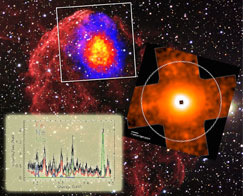About Spectroscopy
Spectroscopy is a complex art, but it is very useful in helping scientists understand how an object like a black hole, neutron star, or active galaxy is producing light, how fast it is moving, and even what elements it is made of. A spectrum is simply a chart or a graph that shows the intensity of light being emitted over a range of eneriges. Spectra can be produced for any energy of light from low-energy radio waves to very high-energy gamma rays.
Spectra are complex because each spectrum holds a wide variety of information. For instance, there are many different mechanisms by which an object, like a star, can produce light – or using the technical term for light, electromagnetic radiation. Each of these mechanisms has a characteristic spectrum.
The pages in this section go into further detail about what spectroscopy is, what processes produce characteristic spectra, and how astronomers use spectra to learn about astronomical objects.
- A quick look at a spectrum
- Take a brief look at a supernova remnant spectrum to see what a typical spectrum plot looks like.
- The electromagnetic spectrum
- Any discussion of the spectrum of light must start with the electromagnetic spectrum - the full spectrum of light.
- Understanding Atoms
- One important feature of spectra are emission lines, but to understand where they come from, it's important to know a thing or two about atoms.
- Line Emission
- Atoms emit light at identifiable energies, which makes the spectrum of an atom just like a fingerprint. This section talks about how these emission lines are produced and how to identify an atom from a spectrum of lines.
- Continuum Emission
- In addition to emitting discrete features, light can be emitted in a continuum, much like a rainbow where you see all colors of the visible spectrum. This section discusses some of the mechanisms that produce X-ray continuum emission.
- Putting it all together: spectra and astronomy
- How do astronomers get information out of spectra from astronomical objects? This section revisits the supernova remnant spectrum and looks at the different parts as an astronomer would see them.

Science Pages